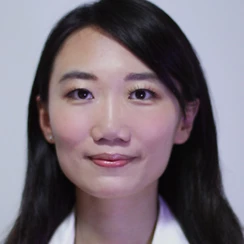
Howard Karagheusian primary health care center, in Beirut, Lebanon on March 23, 2016.
Ali brought his wife and two kids to the health care center to get a vaccine for Cham.
Photo © Dominic Chavez/World Bank
Haya woke up in a panic and gasping for breath. Diagnosed with bronchial asthma as a child, the dusty and humid air in the room caused Haya’s airways to narrow, making breathing unbearably difficult. Her chest continued to tighten, and in the candlelight, she noticed that her fingertips were turning blue. In Syria, Haya had access to health insurance that guaranteed a steady supply of the daily medication she needed to keep her airways open. But Haya and her family fled from Aleppo, settling in a refugee camp near the Syrian border. While the health workers in the camp provided free care for infectious diseases, chronic conditions like Haya’s were referred to the nearby government hospital. Without the means to pay for this care or the right to work in the destination country, Haya was out of drugs and out of breath.
By the end of 2016, the global refugee population stood at 22.5 million people, increasing by 1.1 million over the previous year. Most refugees are hosted in low- and middle-income countries, outside humanitarian camps, and confronted daily with challenges in accessing needed health care. In the 2016 New York Declaration for Refugees and Migrants, the United Nations General Assembly committed to meeting the basic health needs of refugee communities. However, in 2016, there was a 40% funding gap in humanitarian appeals coordinated by the United Nations.
The gap in donor funding for refugees puts inordinate pressure on the budgets of hosting countries: Turkey has spent over US$ 30 billion responding to the Syrian refugee crisis. How should the international development and humanitarian community respond to the gaps in financing for refugee health services? Is there room to expand the funding envelope, increase spending efficiency, and leverage innovations in service delivery to ensure access to care for refugees? These questions were examined during a session at the Third Annual Universal Health Coverage Financing Forum, with panelists representing donor countries, multilateral and bilateral agencies, host countries, and academia.
Innovative financing mechanisms
Over the past five years, innovative financing mechanisms have emerged as possible solution. Along these lines, Haneen Sayed, Program Leader, Middle East and North Africa, World Bank Group, introduced the World Bank Group’s Global Concessional Financing Facility (GCFF). The Facility uses grant funds to buy down interest rates on loans from the International Bank for Reconstruction and Development (IBRD) to middle-income countries affected by refugee crises, such that US$ 1 from supporting countries unlocks up to US$ 4 in concessional loans. The GCFF has supported projects in multiple sectors, in Jordan and Lebanon, and has provided direct budget support to Governments.
The Contingent Emergency Response Component (CERC) has also been introduced into existing and future World Bank projects. The CERC allows countries to quickly mobilize up to 5% of their undisbursed investment project balances following a crisis by reallocation from other project components.
Paul Spiegel, Professor and Director, John Hopkins Center for Humanitarian Health, noted the potential for refugee health insurance to mobilize new resources in situations where refugees are permitted to work. For example, in Iran, 200,000 Afghan refugees are covered through the Salamat Universal Public Health Insurance, with premium contributions subsidized by humanitarian agencies for unemployed refugees.
There are also opportunities to ensure that available funding goes even further to ensure access to health services for refugees. Nancy Izzo Jackson, Bureau of Population, Refugees, and Migration, US State Department, highlighted that donors are increasingly focused on ensuring the efficiency of spending, by linking funding to results over inputs. The first Humanitarian Impact Bond, launched by The International Committee of the Red Cross, established three physical rehabilitation centers in Nigeria, Mali, and the Democratic Republic of Congo, using financing from the private sector. Donors would pay ICRC according to results achieved, and these funds will, in turn, be used to pay back social investors.
Innovative models of service delivery
The breakout session ended with reflections on innovative models of service delivery that respond to the challenge of providing health care to refugees outside of the traditional, short-term and camp-based approach. Randa Hamadeh, Primary Health Care, Ministry of Public Health, Lebanon, reflected on the Lebanese experience of providing services to Syrian refugees. In Lebanon, Syrian refugees can access the same primary care network as host communities at very low cost, as UNHCR covers 85% of visit costs. In 2017, the primary health care network provided more than 1.5 million services, over 45% to Syrian refugees. As a testament to the strength of the primary healthcare network, potential outbreaks of suspected Polio cases originating in eastern Syria have been prevented by large-scale national immunization efforts in Lebanon.
Irina Nikolic, Senior Health Specialist, World Bank, highlighted opportunities for innovative technologies to facilitate effective service delivery for refugees in weaker health systems and humanitarian crises. Using mobile-based tools, Dimagi provides community health workers with support for diagnosis and management in rural and remote areas. Drones for Humanity also enable humanitarian agencies to deliver aid , including medical supplies, in otherwise inaccessible regions efficiently. Furthermore, virtual health workers, enabled by artificial intelligence, could provide health services in systems with acute shortages in skilled human resource for health. These and other similar technologies provide promising alternatives for service delivery to refugees in contexts that face human resource constraints.
While the scale of refugee crises is daunting, the breakout session highlighted opportunities to mobilize finances, efficiently allocate available funding, and improve service delivery models for refugee health care. A newly-created working group on Fragility, Conflict, and Violence in the Health, Nutrition, and Population Global Practice focuses on incorporating these and other innovations in financing and service delivery into World Bank Group Operations.
Haya made it through the night, receiving emergency care from the camp physician. For Haya and the millions of other refugees worldwide, innovative financing and service delivery models that ensure access to health care in their host countries, are essential and could be the difference between life and death.
Follow @wbg_health





Join the Conversation